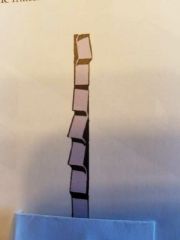![]()
![]()
![]()
Use LEFT and RIGHT arrow keys to navigate between flashcards;
Use UP and DOWN arrow keys to flip the card;
H to show hint;
A reads text to speech;
49 Cards in this Set
- Front
- Back
|
3 types of saws for cutting metal stock |
Reciprocating hack saw, band saw, circular saw |
|
|
Cutting motion for hack saw |
Back and forth cutting on forward stroke |
|
|
Blade doesn't cut on forward stoke on reciprocating hacksaw by |
Cam lifting blade on forward stoke |
|
|
Movement of saw blade in to workpiece |
Feed |
|
|
Apply heavier feed pressure on what type of material |
Soft metals and large work |
|
|
Apply light feed pressure on |
Hard materials and work with small cross section |
|
|
3 tooth rule |
At least 3 teeth must be in contact with workpiece at all times, maximum of 24 teeth |
|
|
Large sections and coarse material require |
Coarse tooth blade |
|
|
Small or thin work and hard material require |
Fine tooth blade |
|
|
4 tooth blade (4 teeth per inch) used for |
Large sections and readily machined material |
|
|
6 tooth blade used for |
Harder alloys and misc. cutting |
|
|
10-14 tooth blade used for what duty saw |
Light duty saws |
|
|
Hacksaw blades made from |
Tungsten or molybdenum steel with carbide teeth |
|
|
2 types of hacksaw blades |
Flexible back blades and all hard blades |
|
|
Features of flexible back blade |
Only teeth hardened, shatter proof Blade, can cut odd shapes |
|
|
Features of all hard blade |
Used for majority of jobs, straight cuts only, more accurate |
|
|
How to tell if hacksaw blade mounted tight enough |
Low pitch ring when tapped, slight elongation on pinholes |
|
|
2 types of band saws |
Horizontal and verticle |
|
|
Horizontal band saws also called |
Cutoff saws |
|
|
3 advantages of band saws |
Faster, greater precision, less waste |
|
|
Describes how teeth on bandsaw blade angled the straight line of the blade |
Tooth set |
|
|
Tooth set does what |
Creates clearance for the blade to prevent overheating |
|
|
3 tooth set patterns on band saw blades |
Raker, wavy, alternative |
|

|
Raker set |
|

|
Wavy set |
|
|
Blade Set for general use |
Raker set |
|
|
Blade set not usually for cutting metals |
Alternative set |
|
|
Determines the efficiency of the blade |
Tooth form |
|
|
3 types of tooth forms |
Standard, skip tooth, hook tooth |
|
|
Blade form best for ferrous metals |
Standard |
|
|
Blade form best for non ferrous metals |
Hook tooth |
|
|
Blade form best for aluminum, magnesium, copper |
Skip tooth |
|

|
Standard tooth |
|

|
Hook tooth |
|

|
Skip tooth |
|
|
4 Common materials for bandsaw blades |
Carbon steel, bimetal, carbide tooth, grit blades |
|
|
Have carbide granules or diamond bonded to toothless blade. |
Grit blades |
|
|
Alloy steel blade with high speed steel teeth |
Bimetal blades |
|
|
Steel blade with tungsten carbide teeth |
Carbide tooth blade |
|
|
For cutting soft metals, wears out fast |
Carbon steel blade |
|
|
For cutting all ferrous and non ferrous metals. More expensive that carbon steel blade |
Bimetal blades |
|
|
Cuts aluminum castings and hard to cut metals like nickel or titanium alloys |
Carbide tooth blades |
|
|
Cuts hard abrasive metals and cast iron |
Grit blades |
|
|
After replacing worn blade midcut never _______ |
Never restart cut in kerf, rotate piece and restart cut |
|
|
Crooked cuts are a result of |
A worn blade |
|
|
3 types of circular saws |
Abrasive cutoff saw, cold circular saw, friction saw |
|
|
Abrasive wheel can be wet or dry |
Abrasive Cutoff saw |
|
|
Circular blade with teeth |
Cold circular saw |
|
|
No teeth, melts metal with friction, if teeth are on blade is for bringing oxygen to cut. Used in steel mill on red hot billets |
Friction saw |

